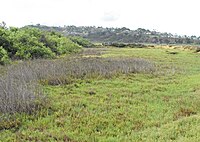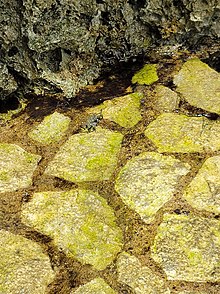Brackish marsh

Brackish marshesdevelop fromsalt marsheswhere a significantfreshwaterinflux dilutes theseawatertobrackishlevels ofsalinity.This commonly happens upstream from salt marshes byestuariesof coastal rivers or near the mouths of coastal rivers with heavy freshwater discharges in the conditions of lowtidal ranges.[1]
Characteristics
[edit]The salinity levels in brackish marshes can range from 0.5 ppt to 35 ppt.[2]Marshes are also characterised by low-growing vegetation and bare mud or sand flats.[3]Due to the variations in salinity, brackish marshes create a distinctiveecosystemwhere plants from either freshwater or saltwater marshes can co-inhabit.[4]The salinity levels also change with thetides,decreasing at low tide and increasing at high tide asoceanwater feeds farther upriver.[5]
Ecosystem Services
[edit]- Reduces coastline erosion[6]
- Provides a coastal buffer from storms[6]
- Mitigates flooding[6]
- Filters and stores excess nitrogen from runoff water[6]
- Provides habitats for aquatic organisms
- Coastal wetlands sequester more carbon than any other environment[7][6]
Biodiversity
[edit]In terms ofbiodiversity,a brackish marsh serves a uniqueecological niche.[8]Its vegetation is a byproduct of its salinity levels. High salinity serves as an evolutionary barrier for most plants, creating a less diverse number of plant species as an ecosystem moves from fresh to saltwater. Thus, there are only a few colonies of saltwater native plants in freshwater and almost no freshwater plants in saltwater ecosystems.[4]However, in brackish marshes both types of plants are prevalent and are in fact high in plant productivity.[4]Examples include, arrow arum (Peltandra virginica), soft rush(Juncus effusus),cattail (Typha), and sawgrass (Cladium).[2]
These plants are usuallyhalophyticin order to survive these conditions.[9]For example brackish sites in Georgia, U.S., are dominated by species such as smooth cord grass (Sporobolusalterniflora),big cordgrass (Spartina cynosuroides),and black rush (Juncus roemerianus).[4]Other communities are cabbage palm (Sabal palmetto), sand cordgrass (Spartina bakeri), black rush (Juncus roemerianus), saltgrass (Distichlis spicata,Paspalum distichum), and mixed halophytes (Batis maritima,Salicomia virginica).[10]Along with salinity, brackish marshes face high physical stress due tofloodingandwave currentscreatingadaptive traitswithin the plant community.[11]
These plant communities also create an environment that provides a nursery for juvenile fish,crustaceans,[12]and birds.[13]Faunause the shallow habitat and the turbidity of the water to protect themselves from predators. Similarly the surface of the marsh is covered with vegetation which is used by thenektonspecies for shelter, leaving enough space to move underneath between the stems.[14]
Thetrophic levelswithin a brackish marsh has been shown to depend on the amount of macroorganic matterin the upper level ofsoil.This macro organic matter is believed to be the food source ofdetritivorebenthic animals that support higher trophic levels. These materials build up as the marsh matures, making age another factor in the biodiversity of a brackish marsh.[14]
Algaealso make up a large part of the biodiversity in brackish marshes. The most common algae,diatoms,make up a large portion of the algal community in brackish marshes.[15]Diatoms areeukaryoticmicroorganisms that have a cell wall that is composed of silica and can exists infreshwateror marine environments making them good candidates for brackish marshes.[15]These diatoms can be eitherplanktic,which float freely in the water column, or benthic, which attach to a substrate.[15]Some examples of diatoms that can be found in brackish marshes are from the genera(Navicula), (Nitzschia), (Diploneis), (Cyclotella), (Cymbella), (Fragilaria), (Gyrosigma),(Tabularia),(Amphora),(Cocconeis),and many more.[16]Many different organisms in these brackish marshes depend on diatoms as a food source so they are ecologically important. Some examples of organisms that feed on diatoms arebivalves,[17]mollusks,[18]fish,[18]copepods,[18]decapod larvae,[18]andducks,[19]as well as many others. Many organisms in these brackish marshes consume diatoms so they are very valuable to maintaining balance in these types of ecosystems.
Another group of algae that is present in brackish marshes are fucoid algae.[20]This is a type of brown macroalgae in the classPhaeophyceae.[20]Brown algae are eukaryotic stramenopiles which means that they are at one point flagellated and most people know them as seaweeds in coastal areas.[21]Examples of brown algae that have been found in brackish marshes areFucus vesiculosus,Ascophyllum nodosum,[20]the genusSphacelaria,[22]and many others.

Yellow-green algaecan also be found in brackish marshes.Yellow-green algaeareeukaryoticalgae in the classXanthophyceae.[23]An example of this isVaucheria.[22]
Green algae can also be found in brackish marshes. Some examples of the different genera of green algae that can be found in brackish marshes areEnteromorpha,Ulothrix,Rhizoclonium,Blidingia,Percursaria,and many others.[22]

Typically,sedgesandgrassesdominate the vegetation in brackish marshes. Plants in brackish marshes are salinity tolerant and they tolerate frequent flooding.[24]They also have frequent tidal waves disturbing the area as well as seasonal hurricanes and tropical storms. (Julia bass) According to (Makenzie) plants in coastal marshes resist salinity by refraining from the uptake of salt via their root system. Some examples of plants that grow in brackish marshes arePanicum hemitomon,Spartina patens,Zostera japonica,Haloxylon recurvum,Juncus roemerianus,Borrichia frutescens,[24]Schoenoplectus americanus,Distichlis spicataand many others.[25]
Human use and impacts
[edit]Brackish marshes are very important forflood control.[11]However, they are often subject to heavy pollution andhabitat degradationfromland reclamation.[12]For example, theIndian River Lagoonhas suffered significant man-made changes since the 1940s. Marshes were oftendredgedorimpoundedto prevent mosquitoes, however this led to the disruption of connectivity by replacing marshes with open water. These changes prevented fires that allowedinvasive speciesto move into the remaining marshes.[10]
Brackish marsh environments are especially susceptible to human degradation; they are ideal areas for land conversion and development because they aren’t rocky and tend to be located in temperate coastal regions. Brackish marshes are areas that can provide connections for both land and water access.[6]
There are many ways humans have disrupted and degraded brackish marshes. When humans divert water from these marshes it leads to land sinking, also known as subsidence. Humans have also modified the vegetation of brackish marshes to change water and sediment flow. Brackish marshes have been subjected to an overabundance of nutrients and pollutants from industrial and urban sources. Environmental stressors from human impact have changed brackish marsh biodiversity to mainly stress-tolerant invasive grasses. Additionally,negative consequencesofclimate change,such assea level rise,will likely begin to harm brackish marsh ecosystems.[6][7]
Brackish marshes can be restored by human intervention. Studies have found that given thatrestorationis properly carried out, fish do not discriminate between restored or natural marshes.[14]
Conservation and threats
[edit]As in most habitats, the greatest threat towards brackish marshes are humans. Traditionally, direct human activities such as dredging and development are the main cause of destruction. Pollution has also been a threat to brackish marshes through chemical run-off.[5]Once degraded, it could take at least 30 to 90 years for restored marsh soil to become equivalent to a natural marsh in terms ofnitrogenandorganic carbonprofile. In some cases, these process could take over 200 years to achieve the wetland soil characteristics of certain communities.[26]
For conservation, the key is to restrict human activities. Installing a passive management system could help restore certain species using brackish marshes' role as an ecological nursery.[27]For some areas, periodic livestockgrazingcould help create a better habitat for certain species of birds.[13]Brackish marshes are a unique type of wetland and the local circumstances are paramount to consider for either conservation, biodiversity, or restoration.
Brackish marshes are also great in reducing nutrient pollution such as nitrogen.[28]There are many sources of nitrogen entering the water systems especially in Texas. In Texas there are many dairy farms as well as ranch land and farm land. All these are sources of nitrogen in the Texas water systems. Having large amounts of nitrogen in a water system can cause eutrophication, harmful algal blooms, and fish kills.[28]In wetlands, nitrogen is used by the vascular and non-vascular vegetation to grow, therefore removing the nitrogen naturally and preventing a large amount of nitrogen from entering the coastal region creating anoxic habitats in the ocean.[28]Conservation of the brackish marsh wetlands can be a last resort to help prevent these potential problems.
References
[edit]- ^Field Guide to Coastal Wetland Plants of the Southeastern United States,Ralph W. Tiner,p. 15
- ^ab"Freshwater vs. Saltwater Wetlands in North Carolina"(PDF).Archived(PDF)from the original on 2021-04-17.
- ^Vernberg, F. John (1993). "Salt-marsh processes: A Review".Environmental Toxicology and Chemistry.12(12): 2167–2195.doi:10.1002/etc.5620121203.ISSN1552-8618.
- ^abcdWięski, Kazimierz; Guo, Hongyu; Craft, Christopher B.; Pennings, Steven C. (2010-01-01)."Ecosystem Functions of Tidal Fresh, Brackish, and Salt Marshes on the Georgia Coast".Estuaries and Coasts.33(1): 161–169.doi:10.1007/s12237-009-9230-4.ISSN1559-2731.S2CID2199915.
- ^ab"Brackish Tidal Marsh Guide - New York Natural Heritage Program".guides.nynhp.org.Retrieved2021-04-17.
- ^abcdefgGedan, K. Bromberg; Silliman, B.R.; Bertness, M.D. (2009-01-01)."Centuries of Human-Driven Change in Salt Marsh Ecosystems".Annual Review of Marine Science.1(1): 117–141.doi:10.1146/annurev.marine.010908.163930.ISSN1941-1405.PMID21141032.
- ^abCoverdale, Tyler C.; Brisson, Caitlin P.; Young, Eric W.; Yin, Stephanie F.; Donnelly, Jeffrey P.; Bertness, Mark D. (2014-03-27)."Indirect Human Impacts Reverse Centuries of Carbon Sequestration and Salt Marsh Accretion".PLOS ONE.9(3): e93296.doi:10.1371/journal.pone.0093296.ISSN1932-6203.PMC3968132.PMID24675669.
- ^Cognetti, Giuseppe; Maltagliati, Ferruccio (2000-01-01)."Biodiversity and Adaptive Mechanisms in Brackish Water Fauna".Marine Pollution Bulletin.40(1): 7–14.doi:10.1016/S0025-326X(99)00173-3.ISSN0025-326X.
- ^Dijkema, Kees S. (1990-01-01)."Salt and brackish marshes around the Baltic Sea and adjacent parts of the North Sea: Their vegetation and management".Biological Conservation.51(3): 191–209.doi:10.1016/0006-3207(90)90151-E.ISSN0006-3207.
- ^abSchmalzer, Paul A. (1995-07-01)."Biodiversity of Saline and Brackish Marshes of the Indian River Lagoon: Historic and Current Patterns".Bulletin of Marine Science.57(1): 37–48.
- ^abCarus, Jana; Paul, Maike; Schröder, Boris (2016)."Vegetation as self-adaptive coastal protection: Reduction of current velocity and morphologic plasticity of a brackish marsh pioneer".Ecology and Evolution.6(6): 1579–1589.doi:10.1002/ece3.1904.ISSN2045-7758.PMC4801978.PMID27087929.
- ^abCattrijsse, A; Makwaia, Es; Dankwa, Hr; Hamerlynck, O; Hemminga, Ma (1994)."Nekton communities of an intertidal creek of a European estuarine brackish marsh"(PDF).Marine Ecology Progress Series.109:195–208.Bibcode:1994MEPS..109..195C.doi:10.3354/meps109195.ISSN0171-8630.
- ^abMandema, Freek S.; Tinbergen, Joost M.; Ens, Bruno J.; Koffijberg, Kees; Dijkema, Kees S.; Bakker, Jan P. (2015-09-01)."Moderate livestock grazing of salt, and brackish marshes benefits breeding birds along the mainland coast of the Wadden Sea".The Wilson Journal of Ornithology.127(3): 467–476.doi:10.1676/13-133.1.ISSN1559-4491.S2CID83788168.
- ^abcHampel, H; Cattrijsse, A; Vincx, M (2003-01-01)."Habitat value of a developing estuarine brackish marsh for fish and macrocrustaceans".ICES Journal of Marine Science.60(2): 278–289.doi:10.1016/S1054-3139(03)00013-4.ISSN1054-3139.
- ^abcPfister, Laurent; McDonnell, Jeffrey J.; Wrede, Sebastian; Hlubikova, Dasa; Matgen, Patrick; Fenicia, Fabrizio; Ector, Luc; Hoffmann, Lucien (August 5, 2009)."The rivers are alive: on the potential for diatoms as a tracer of water source and hydrological connectivity".Hydrological Processes.23(19): 2841–2845.doi:10.1002/hyp.7426.S2CID33508939– via Wiley online library.
- ^Parsons, Michael L.; Dortch, Quay; Turner, R. Eugene; Rabalais, Nancy N. (December 1999)."Salinity History of Coastal Marshes Reconstructed from Diatom Remains".Estuaries.22(4): 1078.doi:10.2307/1353085.ISSN0160-8347.JSTOR1353085.S2CID84822337.
- ^Davenport, John; Ezgeta-Balić, Daria; Peharda, Melita; Skejić, Sanda; Ninčević-Gladan, Živana; Matijević, Slavica (April 2011)."Size-differential feeding in Pinna nobilis L. (Mollusca: Bivalvia): Exploitation of detritus, phytoplankton and zooplankton".Estuarine, Coastal and Shelf Science.92(2): 246–254.doi:10.1016/j.ecss.2010.12.033.ISSN0272-7714.
- ^abcdLebour, Marie V. (October 1922)."The Food of Plankton Organisms".Journal of the Marine Biological Association of the United Kingdom.12(4): 644–677.doi:10.1017/S0025315400009681.ISSN1469-7769.S2CID53656496.
- ^Atkinson, Kathleen M. (1972-11-15)."Birds as transporters of algae".British Phycological Journal.7(3): 319–321.doi:10.1080/00071617200650331.ISSN0007-1617.
- ^abcTyrrell, Megan C.; Dionne, Michele; Eberhardt, Sarah A. (May 2012)."Salt Marsh Fucoid Algae: Overlooked Ecosystem Engineers of North Temperate Salt Marshes".Estuaries and Coasts.35(3): 754–762.doi:10.1007/s12237-011-9472-9.ISSN1559-2723.S2CID86377945.
- ^Cock, J. Mark; Peters, Akira F.; Coelho, Susana M. (August 2011)."Brown algae".Current Biology.21(15): R573–R575.doi:10.1016/j.cub.2011.05.006.ISSN0960-9822.PMID21820616.S2CID9779828.
- ^abcNienhuis, P. H. (1987), Huiskes, A. H. L.; Blom, C. W. P. M.; Rozema, J. (eds.),"Ecology of salt-marsh algae in the Netherlands: A Review",Vegetation between land and sea,Dordrecht: Springer Netherlands, pp. 66–85,doi:10.1007/978-94-009-4065-9_6,ISBN978-94-010-8305-8,retrieved2023-03-02
- ^Gallagher, Susan B. (1981)."Vaucheria (Xanthophyceae, Vaucheriaceae) of the Central Florida Gulf Coast".Bulletin of Marine Science.31(1): 184–190 – via Ingenta.
- ^abJenkins, Mackenzie L.; Schafer, Jennifer L. (2022)."Salt Marsh Plant Community Structure on Horse Island, South Carolina".Journal of the South Carolina Academy of Science.20(2): 9–12 – via Academic Search Complete.
- ^Gabriel, Jared R.; Reid, Jessica; Wang, Le; Mozdzer, Thomas J.; Whigham, Dennis F.; Megonigal, J. Patrick; Langley, J. Adam (September 2022)."Interspecific Competition is Prevalent and Stabilizes Plant Production in a Brackish Marsh Facing Sea Level Rise".Estuaries and Coasts.45(6): 1646–1655.doi:10.1007/s12237-021-01043-9.ISSN1559-2723.S2CID245856791.
- ^Craft, Christopher; Broome, Stephen; Campbell, Carlton (2002)."Fifteen Years of Vegetation and Soil Development after Brackish-Water Marsh Creation".Restoration Ecology.10(2): 248–258.doi:10.1046/j.1526-100X.2002.01020.x.ISSN1526-100X.S2CID55198244.
- ^Agha, Mickey; Yackulic, Charles B.; Riley, Melissa K.; Peterson, Blair; Todd, Brian D. (2020-10-01)."Brackish Tidal Marsh Management and the Ecology of a Declining Freshwater Turtle".Environmental Management.66(4): 644–653.doi:10.1007/s00267-020-01326-0.ISSN1432-1009.PMID32651626.S2CID220462500.
- ^abcCheng, F. Y.; Van Meter, K. J.; Byrnes, D. K.; Basu, N. B. (December 2020)."Maximizing US nitrate removal through wetland protection and restoration".Nature.588(7839): 625–630.doi:10.1038/s41586-020-03042-5.ISSN1476-4687.PMID33328640.S2CID229300707.




